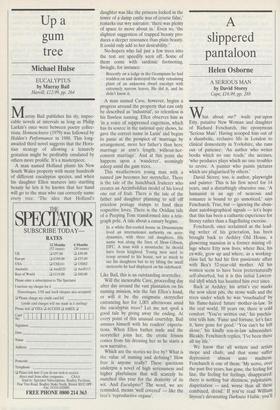Up a gum tree
Michael Hulse
EUCALYPTUS by Murray Bail Harvill, E12.99, pp. 264 Murray Bail publishes his sly, impec- cable novels at intervals as long as Philip Larkin's once were between poetry collec- tions. Homesickness (1979) was followed by Holden's Performance in 1988. This long- awaited third novel suggests that the Hora- tian strategy of allowing a leisurely gestation might be profitably emulated by others more prolific. It's a masterpiece.
A man named Holland plants his New South Wales property with many hundreds of different eucalyptus species, and when his daughter Ellen matures into startling beauty he lets it be known that her hand will go to the man who can correctly name every tree. 'The idea that Holland's daughter was like the princess locked in the tower of a damp castle was of course false,' remarks our wry narrator: 'there was plenty of space to move about in.' Even so, 'the slightest suggestion of trapped beauty pro- duces a deeper resonance than plain beauty. It could only add to her desirability.'
No-hopers who fail just a few trees into the test are speedily seen off. Some of Swingle, for instance:
Recently on a ledge in the Grampians he had trodden on and destroyed the only remaining plant of an unknown dwarf eucalypt with extremely narrow leaves. He did it, and he didn't know it.
A man named Cave, however, begins a progress around the property that can only be described as 'industrial', so relentless is his flawless naming. Ellen observes him as 'in a voice of suppressed eagerness, which has its source in the national quiz shows, he gave the correct name in Latin' and begins to panic at the prospect of 'marriage by arrangement, more her father's than hers; marriage at arm's length; without-her- consent marriage'. And at this point she happens upon a 'wanderer', seemingly asleep amid the gum trees.
This weatherwom young man with a tanned jaw becomes her storyteller. There is the tale of the hunchback fruiterer who creates an Arcimboldian model of his loved one out of fruit. There is the tale of the father and daughter planning to sell off priceless postage stamps to fund their respective loves. There is the Ovidian tale of a Peeping Tom transformed into a tele- graph pole. A tale about a canary begins:
In a white flat-roofed house in Drummoyne lived an international authority on aero- dynamics, with three tall daughters. His name was along the lines of Shaw-Gibson, DFC. A man with a moustache: he should have been knighted. Young men used to troop around to his house, not so much to see his daughters but to try lifting the small meteorite he had displayed on his sideboard.
Like Bail, this is an outstanding storyteller.
Will the inexorable Cave, proceeding day after day around the vast plantation on his naming mission, win the fair Ellen's hand, or will it be the enigmatic storyteller entrancing her for 1,001 afternoons amid the eucalyptus trees? Let me not spoil a good tale by giving away the ending. At every point of this unusual courtship, Bail amuses himself with his readers' expecta- tions. When Ellen bathes nude and the storyteller joins her, the erotic frisson comes from his dressing her as he starts a new narrative.
Which are the stories we live by? What is the value of naming and defining? How free is anyone really? These questions underpin a novel of high seriousness and higher playfulness that will scarcely be matched this year for the dexterity of its wit. And Eucalyptus? The word, we are reminded, means 'well covered' — like the tree's 'reproductive organs'.


























































 Previous page
Previous page